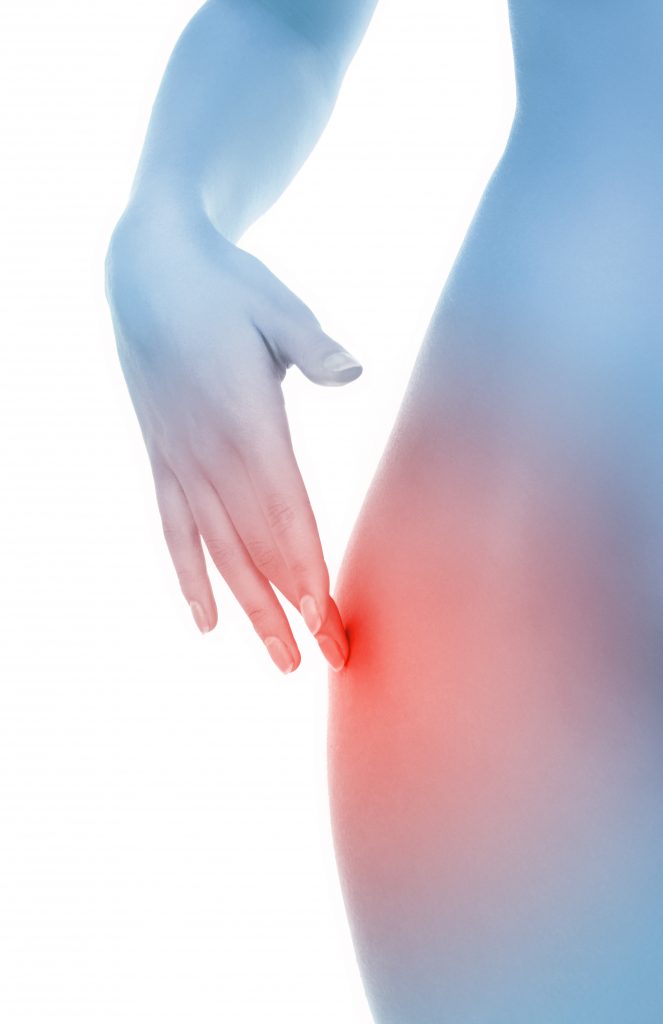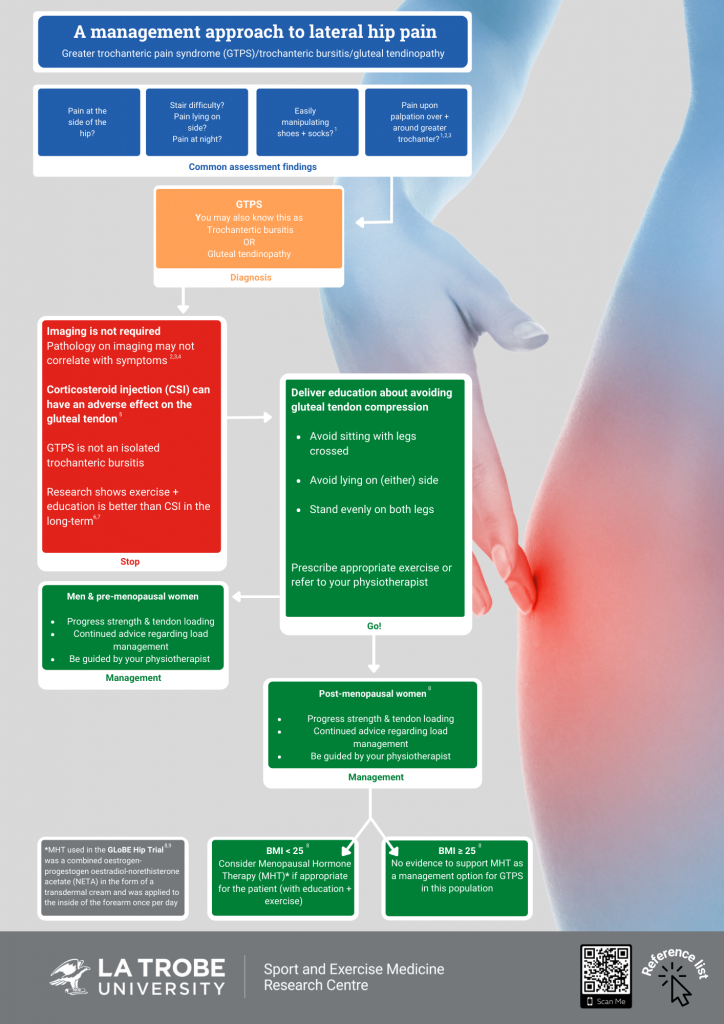A management approach to lateral hip pain
Greater trochanteric pain syndrome (GTPS) clinically refers to lateral hip pain (pain at the side of the hip and upper thigh)1,2. GTPS is a debilitating and chronic condition, seen in all age groups and in both men and women2. The condition is, however, most prevalent in post-menopausal women1,2. One of the reasons for this increased prevalence in post-menopausal women is the reduced levels of circulating female sex hormones.
Our research team at La Trobe University completed a blinded 2 x 2 factorial RCT, investigating menopausal hormone therapy and exercise as interventions for post-menopausal women with GTPS. Results of this RCT (GLoBE Hip Trial) were published in The American Journal of Sports Medicine.
Results showed any exercise in combination with education is beneficial for people with GTPS, aligning with existing research. In addition, hormone therapy with exercise and education was better than placebo with exercise and education when BMI<25. Clinically, these findings suggest hormone therapy with exercise and education may be a viable intervention option for post-menopausal women with GTPS and BMI<25.
We developed an educational infographic to promote these findings to a range of clinicians especially sports physicians and general practitioners.
Medical practitioners can provide
i) direct advice on non-surgical management
ii) referral to physiotherapists for exercise and load management
iii) hormone replacement therapy prescription where appropriate
Author(s):
Rachael Mary Cowan, PhD, MSc Physiotherapy (Pre-Reg), MSc Biomed Health Sc (Anatomy), La Trobe Sport and Exercise Medicine Research Centre, La Trobe University and Physiotherapist at Rachael Cowan Physiotherapy, Newton, Victoria, Australia
Matthew Wirdnam, MSc Applied Science (Current), MSc Physiotherapy, BSc Biomed Sc (Advanced Biochemistry), La Trobe Sport and Exercise Medicine Research Centre, La Trobe University and Physiotherapist at Pursue Health, Highett, Victoria, Australia
Competing interests:
None
References:
- Fearon, A. M., Scarvell, J. M., Neeman, T., Cook, J. L., Cormick, W., & Smith, P. N. (2013). Greater trochanteric pain syndrome: defining the clinical syndrome. British Journal of Sports Medicine, 47(10), 649-653. doi:10.1136/bjsports-2012-091565
- Ganderton, C., Semciw, A., Cook, J., & Pizzari, T. (2017). Demystifying the Clinical Diagnosis of Greater Trochanteric Pain Syndrome in Women. Journal of women’s health (2002), 26(6), 633–643. https://doi.org/10.1089/jwh.2016.5889
- Grimaldi, A., Mellor, R., Nicolson, P., Hodges, P., Bennell, K., & Vicenzino, B. (2017). Utility of clinical tests to diagnose MRI-confirmed gluteal tendinopathy in patients presenting with lateral hip pain. British Journal of Sports Medicine, 51(6), 519-524. doi:10.1136/bjsports-2016-096175
- Blankenbaker, D. G., Ullrick, S. R., Davis, K. W., De Smet, A. A., Haaland, B., & Fine, J. P. (2008). Correlation of MRI findings with clinical findings of trochanteric pain syndrome. Skeletal radiology, 37(10), 903–909. https://doi.org/10.1007/s00256-008- 0514-8
- Shalaby M, Almekinders LC. (1999) Patellar tendinitis: the significance of magnetic resonance imaging findings. Am J Sports Med. 27:345–349
- Long, S. S., Surrey, D. E., & Nazarian, L. N. (2013). Sonography of greater trochanteric pain syndrome and the rarity of primary bursitis. AJR. American journal of roentgenology, 201(5), 1083–1086. https://doi.org/10.2214/AJR.12.10038
- Mellor, R., Bennell, K., Grimaldi, A., Nicolson, P., Kasza, J., Hodges, P., Wajswelner, H., & Vicenzino, B. (2018). Education plus exercise versus corticosteroid injection use versus a wait and see approach on global outcome and pain from gluteal tendinopathy: prospective, single blinded, randomised clinical trial. British journal of sports medicine, 52(22), 1464– 1472. https://doi.org/10.1136/bjsports-2018-k1662rep
- Cowan, R. M., Ganderton, C. L., Cook, J., Semciw, A. I., Long, D. M., & Pizzari, T. Does menopausal hormone therapy, exercise, or both improve pain and function in postmenopausal women with greater trochanteric pain syndrome? A 2 × 2 factorial randomized clinical trial. The American Journal of Sports Medicine, 0(0), 03635465211061142. https://doi.org/10.1177/03635465211061142
- Ganderton, C., Semciw, A., Cook, J., & Pizzari, T. (2016). Does menopausal hormone therapy (MHT), exercise or a combination of both, improve pain and function in post- menopausal women with greater trochanteric pain syndrome (GTPS)? A randomised controlled trial. BMC Women’s Health, 16, 32. doi:10.1186/s12905-016-0311-9


